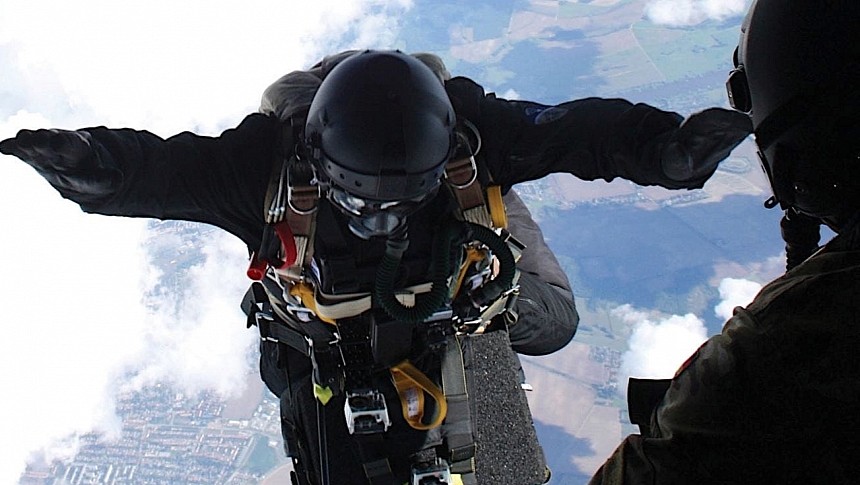There is no question in my mind military parachutists have one of the most dangerous jobs in the world. Not only do they have to drop from the sky right in the middle of a battlefield or behind enemy lines, but before doing that they must survive the adverse conditions they encounter on the way down.
The idea of people jumping out of perfectly fine airplanes and heading into combat dates back to the 1930s, when pre-war Germany first experimented with the idea. It quickly spread to neighboring Netherlands, Belgium, Denmark and Norway, and by the time the Second World War ended, scores of human beings from most nations were involved in this kind of activity.
Naturally, the parachute drops of WWII were nothing as they are today. Soldiers from that era generally dropped from an altitude of up to 2,100 feet (640 meters), so there was little need for specialized hardware to be provided for them to be able to breathe or survive extreme temperatures and pressures.
By comparison, today's special forces paratroopers launch from as high as 33,000 feet (10,000 feet). These are called high-altitude jumps, and can end in either high-altitude opening of the parachute (HAHO), or low-altitude (HALO). No matter how the jumps end, though, humans need a breathing apparatus to survive the early minutes of the drop.
And this is where things like the Collins Aerospace Oxyjump system come in. Specifically designed to supply paratroopers with the breathing air they need during descent from high up, it works by constantly adjusting the mix of oxygen "even under extreme environmental conditions."
The system comprises two cylinders filled with life-supporting gas, held at a pressure of 200 bar (3,000 psi). It can be used on most tactical parachute systems, including tandem, and it is suitable for both pressure-compensated and non-pressure-compensated masks.
That's the Oxyjump we already know of, as a new one, called Oxyjump NG, is presently being shown by Collins at SOF Week 2023, an event dedicated to Special Operations Forces and their gear.
This one comes with its own mask, and was designed to enable "longer glide duration on higher altitude jumps, maximizing oxygen use and reducing system weight." What exactly that means in terms of capabilities was not disclosed.
At the time of writing, America has paratrooper forces all across its military branches, and down to special operation forces level. The most famous such unit is the 82nd Airborne Division, an Army formation now acting as a rapid response force, capable of reaching any place on this Earth within 18 hours.
Regular paratrooper units don't generally jump from as high as to need an oxygen supply system, so the Oxyjump is meant for more covert missions, ones that need stealth approach and rapid insertion.
Naturally, the parachute drops of WWII were nothing as they are today. Soldiers from that era generally dropped from an altitude of up to 2,100 feet (640 meters), so there was little need for specialized hardware to be provided for them to be able to breathe or survive extreme temperatures and pressures.
By comparison, today's special forces paratroopers launch from as high as 33,000 feet (10,000 feet). These are called high-altitude jumps, and can end in either high-altitude opening of the parachute (HAHO), or low-altitude (HALO). No matter how the jumps end, though, humans need a breathing apparatus to survive the early minutes of the drop.
And this is where things like the Collins Aerospace Oxyjump system come in. Specifically designed to supply paratroopers with the breathing air they need during descent from high up, it works by constantly adjusting the mix of oxygen "even under extreme environmental conditions."
The system comprises two cylinders filled with life-supporting gas, held at a pressure of 200 bar (3,000 psi). It can be used on most tactical parachute systems, including tandem, and it is suitable for both pressure-compensated and non-pressure-compensated masks.
That's the Oxyjump we already know of, as a new one, called Oxyjump NG, is presently being shown by Collins at SOF Week 2023, an event dedicated to Special Operations Forces and their gear.
This one comes with its own mask, and was designed to enable "longer glide duration on higher altitude jumps, maximizing oxygen use and reducing system weight." What exactly that means in terms of capabilities was not disclosed.
At the time of writing, America has paratrooper forces all across its military branches, and down to special operation forces level. The most famous such unit is the 82nd Airborne Division, an Army formation now acting as a rapid response force, capable of reaching any place on this Earth within 18 hours.
Regular paratrooper units don't generally jump from as high as to need an oxygen supply system, so the Oxyjump is meant for more covert missions, ones that need stealth approach and rapid insertion.






